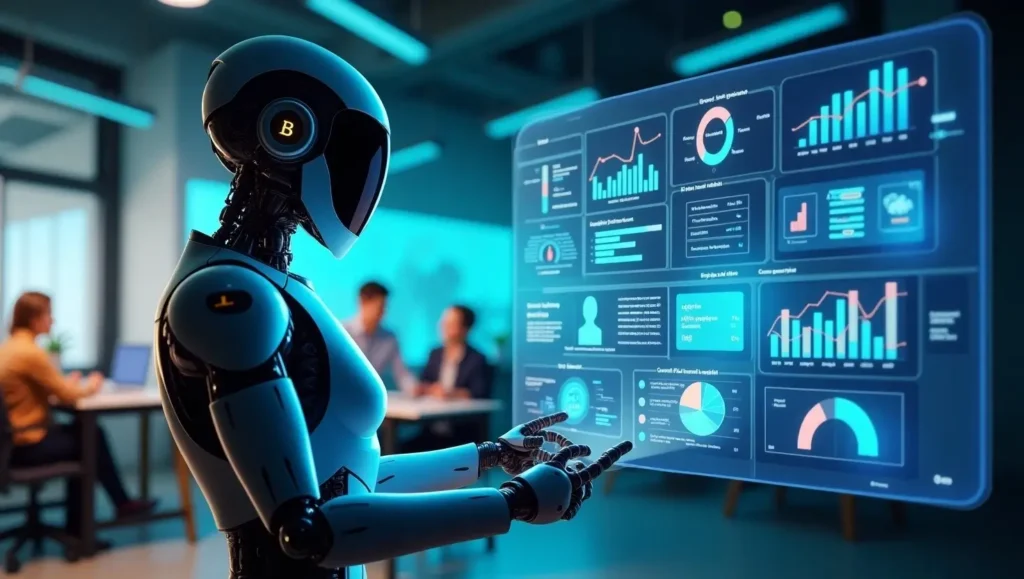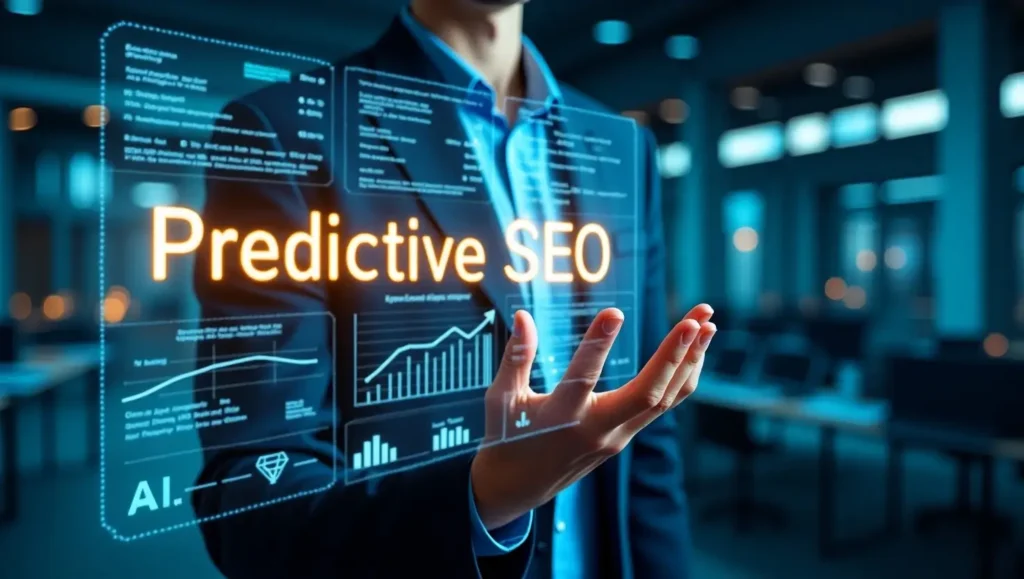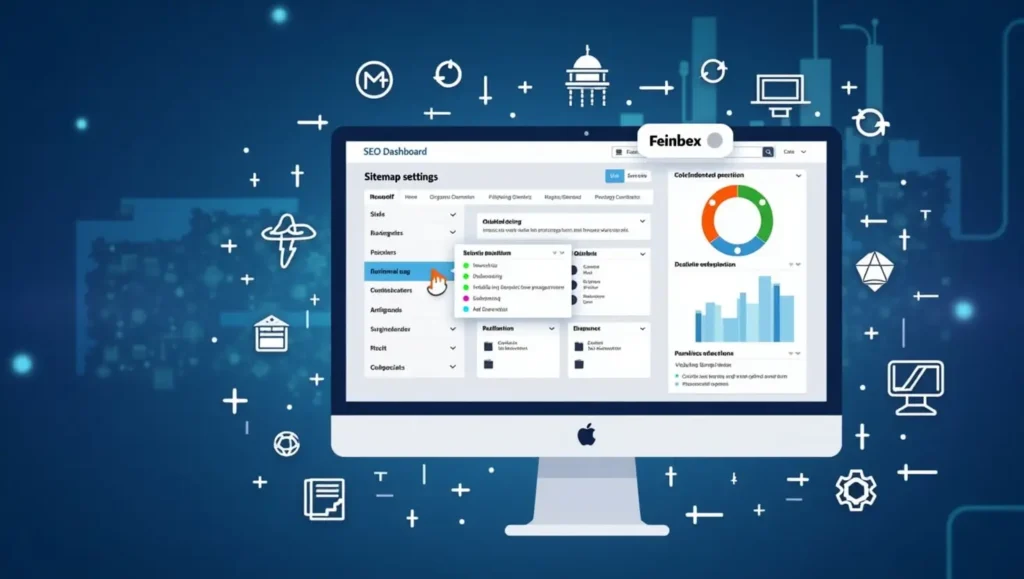The digital landscape is evolving rapidly, and SEO strategies that worked yesterday may not be as effective tomorrow. Businesses need to anticipate search engine algorithm updates, user intent shifts, and industry trends to stay ahead. This is where Predictive SEO comes in. By leveraging artificial intelligence (AI) and machine learning (ML), marketers can forecast search trends, optimize content proactively, and gain a competitive edge in rankings. In this article, we will explore how Predictive SEO aligns with AI-driven SEO tools to scale agile solutions, providing actionable insights and real-world examples.For a broader understanding of AI-powered SEO tools, check out 7 Powerful Features of AI-Powered SEO Tools and Their Game-Changing Benefits.
Table of Contents
ToggleUnderstanding Predictive SEO
Predictive SEO is the practice of using AI and data analytics to forecast future search engine ranking factors, user behavior, and content trends. Instead of reacting to algorithm changes, businesses can proactively adapt their SEO strategies based on AI-driven insights. For more on how AI enhances SEO, read AI SEO Automation: Top Scaling Solutions to Dominate 2025.
Key components of Predictive SEO include:
- Trend Analysis: Identifying emerging search trends before they peak.
- User Behavior Prediction: Analyzing historical data to anticipate user intent.
- AI-Powered Content Recommendations: Generating content ideas based on future ranking potential.
- Algorithmic Adaptation: Adjusting SEO strategies based on anticipated search engine updates.

How AI Enhances Predictive SEO
1. AI-Powered Keyword Forecasting
AI tools analyze vast amounts of search data to predict which keywords will gain traction in the future. Platforms like Google’s Search Console, Ahrefs, and SEMrush use machine learning to provide keyword trend insights. Predictive AI can identify long-tail keywords that may become high-traffic search queries, allowing businesses to optimize content ahead of time.
Keyword forecasting helps businesses avoid content stagnation and target keywords with future ranking potential, ensuring sustained traffic growth.
2. Automated Content Optimization
AI-driven platforms like Clearscope and Surfer SEO analyze top-performing content and provide recommendations to enhance keyword relevance, readability, and engagement. For more on AI-driven content creation, read Master AI Content and Agile SEO in 2025: The Game-Changing Formula. These tools help marketers create future-proof content that aligns with upcoming ranking trends.
Using AI, businesses can analyze competitors’ content strategies, detect content gaps, and generate highly relevant topics based on future search intent. Automated optimization also ensures that existing content remains relevant by continuously adapting to SEO changes.
3. Predictive Analytics for Technical SEO
AI-powered analytics tools can identify technical SEO issues before they impact rankings. Google’s Core Web Vitals, for example, highlights performance issues that may become critical ranking factors in future algorithm updates. AI-driven site audit tools like Screaming Frog and DeepCrawl help businesses optimize their websites proactively.
By leveraging AI for technical SEO, brands can detect slow-loading pages, broken links, and schema markup issues, improving the overall user experience and boosting rankings in advance of algorithmic shifts. For best practices in technical SEO, visit Revolutionizing Technical SEO with AI: 7 Best Practices for 2025.
4. Voice and Visual Search Adaptation
With AI’s ability to analyze voice and image-based search trends, businesses can optimize for voice search queries and image recognition algorithms. This is especially crucial as smart assistants and visual search engines like Google Lens continue to gain popularity.
By using natural language processing (NLP) models, brands can tailor content for conversational queries, increasing their chances of ranking for voice searches. Similarly, AI-based image recognition tools can optimize product images and infographics for enhanced visibility in visual search results.
Real-World Examples of Predictive SEO Success
E-commerce Growth
A leading online retailer used AI-driven predictive SEO to analyze seasonal trends and optimize product pages ahead of demand spikes. By adjusting metadata, internal linking, and category structures, they achieved a 30% increase in organic traffic and a significant boost in conversion rates.
Content Strategy Enhancement
A SaaS company leveraged AI-powered keyword forecasting to identify emerging industry terms, allowing them to rank for high-value keywords before competitors. This proactive approach led to a 50% increase in inbound leads and established them as thought leaders in their niche.
Local SEO Optimization
A multi-location business used AI insights to adapt to local search trends, improving local pack rankings by 40%. AI-driven data helped them refine geo-targeted content, optimize Google Business Profiles, and predict local search behaviors.

Actionable Strategies for Implementing Predictive SEO
1. Leverage AI-Driven SEO Tools
Use platforms like MarketMuse, Frase, and BrightEdge to analyze keyword trends and forecast content performance. AI can suggest content updates, identify underperforming pages, and help maintain a strong search presence.
2. Monitor Search Trends Regularly
Stay ahead by using Google Trends and AI-powered analytics to track emerging search queries. Set up alerts and reports to monitor shifts in keyword volume and user behavior.
3. Optimize for Emerging Technologies
Ensure content is optimized for voice search, AI-generated snippets, and video-based search. AI-powered transcription and structured data implementation can improve rankings for voice and visual queries.
4. Adopt an Agile SEO Strategy
Implement a flexible content strategy that adapts to real-time AI insights and search engine updates. Use A/B testing to refine content formats, metadata, and keyword targeting strategies based on AI-driven recommendations.
5. Integrate Predictive Analytics with Content Planning
Use AI-powered data models to identify trending topics and create content calendars that align with future search demands. This approach ensures that your brand consistently produces high-performing content.
6. Improve User Experience (UX) with AI Insights
Predictive AI tools analyze bounce rates, dwell time, and user interactions to provide UX optimization recommendations. Enhancing website usability and page speed based on AI-driven insights can lead to higher rankings and engagement.
Conclusion: Stay Ahead with Predictive SEO
Predictive SEO is transforming the way businesses approach search engine rankings. By leveraging AI-driven insights, brands can proactively optimize content, enhance technical SEO, and stay ahead of industry trends. The integration of AI SEO tools with agile solutions ensures a sustainable and scalable digital presence. For more on AI-driven SEO strategies, check out Top 7 AI SEO Tools for Scaling Agile Solutions Like an Expert.
In an ever-changing search landscape, the key to long-term SEO success lies in data-driven foresight and continuous adaptation. By incorporating AI-powered keyword forecasting, content automation, and predictive analytics into your SEO strategy, you can secure higher rankings and increase organic traffic.
FAQs
1. What is Predictive SEO?
Predictive SEO is the practice of using AI and data analytics to forecast future search trends, ranking factors, and user behavior, allowing businesses to optimize content proactively rather than reactively.
2. How does AI improve SEO predictions?
AI enhances SEO by analyzing large datasets, search engine algorithms, and user intent trends to predict keyword opportunities, content relevance, and ranking shifts before they happen.
3. What are some AI-powered tools for Predictive SEO?
Some leading AI-driven SEO tools include:
- Google Search Console – Provides insights into search performance and technical issues.
- Ahrefs & SEMrush – Helps in keyword forecasting and competitor analysis.
- Surfer SEO & Clearscope – Offers AI-based content optimization recommendations.
- Screaming Frog & DeepCrawl – Conducts AI-powered site audits for technical SEO improvements.
4. How can businesses implement Predictive SEO effectively?
To leverage Predictive SEO, businesses should:
- Use AI-driven SEO tools to analyze trends.
- Monitor search behavior changes using tools like Google Trends.
- Optimize for emerging technologies like voice and visual search.
- Continuously update content based on AI insights.
- Adopt an agile SEO strategy that adapts to ranking shifts.
5. What role does machine learning play in Predictive SEO?
Machine learning helps by continuously analyzing user behavior, content engagement, and ranking patterns, enabling businesses to adapt their SEO strategies dynamically.
6. How does Predictive SEO help with keyword research?
AI-powered keyword forecasting tools analyze search volume trends, seasonal fluctuations, and competitor data to identify keywords that will gain traction in the future.
7. Is Predictive SEO useful for small businesses?
Yes! Small businesses can benefit from Predictive SEO by focusing on local search trends, long-tail keyword forecasting, and AI-driven content optimization to stay ahead of competitors.
8. How does Predictive SEO impact content marketing?
Predictive SEO allows marketers to identify trending topics, optimize content before competitors, and enhance engagement by targeting emerging search queries.
9. What are the biggest challenges of Predictive SEO?
- Keeping up with AI and search engine updates.
- Interpreting AI-driven insights accurately.
- Balancing automation with human creativity.
- Ensuring data privacy and ethical AI usage.
10. What is the future of Predictive SEO?
As AI continues to advance, Predictive SEO will become even more precise, enabling businesses to automate keyword research, personalize content dynamically, and optimize for evolving search trends with greater accuracy.



